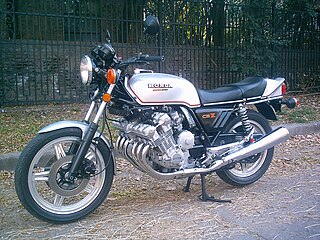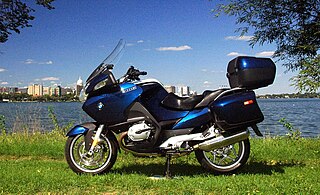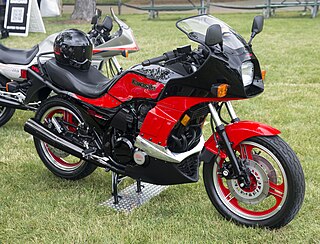
In an internal combustion engine, a turbocharger is a forced induction device that is powered by the flow of exhaust gases. It uses this energy to compress the intake air, forcing more air into the engine in order to produce more power for a given displacement.

A straight-four engine is a four-cylinder piston engine where cylinders are arranged in a line along a common crankshaft.

AMA Superbike Championship is an American motorcycle racing series that has been run every year beginning in 1976. For most of its existence it has been considered the premier motorcycle road racing series in the United States. It is sanctioned by the AMA American Motorcyclist Association since its inception, and the promotion of the series has been licensed to several organizations over the years. Since 2015 the series has been run and promoted by MotoAmerica, who also manage several other AMA professional road racing championships, including the popular 600cc Supersport class.

The Lancia Delta S4 is a Group B rally car manufactured by the Italian car company Lancia. The Delta S4 competed in the World Rally Championship in 1985 and 1986, until Group B class was disbanded and the cars were eventually banned from competition completely by European sanctioning body FIA. The car replaced, and was an evolution of, the 037. The S4 took full advantage of the Group B regulations, and featured a midship-mounted engine and all-wheel drive for superior traction on loose surfaces.

The Honda CBX sports motorcycle was manufactured by Honda from 1978 to 1982. With a 1047cc inline six-cylinder engine producing 105 bhp (78 kW), it was the flagship of the Honda range. The CBX was well-received by the press, but was outsold by its sibling introduced in late 1979, the Honda CB900F.

A motorcycle engine is an engine that powers a motorcycle. Motorcycle engines are typically two-stroke or four-stroke internal combustion engines, but other engine types, such as Wankels and electric motors, have been used.

Pro Modified, also known as Pro Mod, is a class or division in the sport of drag racing used in the NHRA and FIA (quarter-mile) and the Professional Drag Racers Association (PDRA) (eighth-mile). It is similar to the Top Doorslammer class as defined by the ANDRA.

The BMW M12/13 turbo was a 1,499.8 cc four-cylinder turbocharged Formula One engine, based on the standard BMW M10 engine introduced in 1961, and powered the F1 cars of Brabham, Arrows and Benetton. Nelson Piquet won the FIA Formula One Drivers' Championship in 1983 driving a Brabham powered by the BMW M12/13 turbo. It was the first Drivers' Championship to be won using a turbocharged engine. The engine also powered the BMW GTP and in the 2.0-litre naturally-aspirated form, the successful March Engineering Formula Two cars. BMW engineers estimated the engine produced around 1,400 hp at maximum boost, however the BMW engine dynamometer could not go beyond 1,280 bhp.

The BMW R1200RT is a touring or sport touring motorcycle that was manufactured from 2005 to 2019 by BMW Motorrad to replace the R1150RT model. It features a 1,170 cc (71 cu in) flat-twin engine with a six-speed gearbox and shaft drive.

In an internal combustion engine, a supercharger compresses the intake gas, forcing more air into the engine in order to produce more power for a given displacement.

The Kawasaki GPz750 Turbo was a sportbike manufactured from late 1983 to 1985, with two model years – the 1984 E1 and the 1985 E2. Differences were minor, a twin "push/pull" throttle cable for the E2 and different brake caliper stickers. The bike was manufactured in Japan, with parts also shipped to the US and assembled in Kawasaki's Nebraska plant for the US/Canada market to bypass the import tax levied on bikes over 700cc at the time by the US government, a protectionist move designed to save Harley-Davidson which was having financial problems at the time.
This article gives an outline of Formula One engines, also called Formula One power units since the hybrid era starting in 2014. Since its inception in 1947, Formula One has used a variety of engine regulations. Formulae limiting engine capacity had been used in Grand Prix racing on a regular basis since after World War I. The engine formulae are divided according to era.

The BMW F650 is a family of motorcycles developed by BMW Motorrad beginning in 1993. Models included the F650St Strada and from 1994, the F650 which, due to some subtle differences, was considered to be a more dual/multi purpose motorcycle with some off-road capability. The 1993 - 2000 F650 was the first single-cylinder motorcycle from BMW since the 1960–1966 R27, and the first chain driven motorcycles from BMW.

The BMW K1600GT, K1600GTL, and K1600B are motorcycles manufactured by BMW Motorrad. The former two were announced in July 2010, unveiled at the Intermot motorcycle show in Cologne in October 2010; they went on sale in March 2011. The latter was announced in October 2016. The K1600GTL is a full dress luxury tourer, which replaced the K1200LT. It was intended to compete with the Honda Gold Wing. The K1600GT was more of a sport tourer similar to the then-existing K1300GT and previous K1200GT models. The K1600B is a bagger designed primarily for the North American market.

The Kawasaki H1 Mach III was a two-stroke 500 cc sport bike made by Kawasaki from 1969 through to 1975.
Turbochargers have been used on various petrol engines since 1962, in order to obtain greater power or torque output for a given engine displacement.

The Kawasaki Ninja H2 is a supercharged four-stroke supersport-class motorcycle in the Ninja sports bike series manufactured by Kawasaki, featuring a variable-speed centrifugal supercharger.

The BMW WR 750 was a supercharged racing motorcycle from BMW with two-cylinder, four-stroke flat twin engine that was first built in 1929, and developed through 1935 solely for racing by the factory.
















